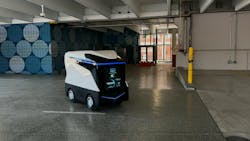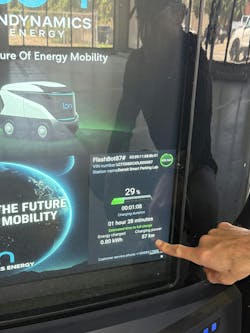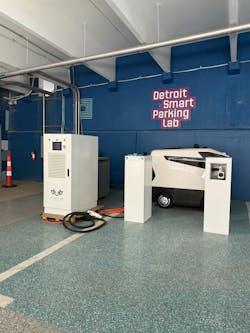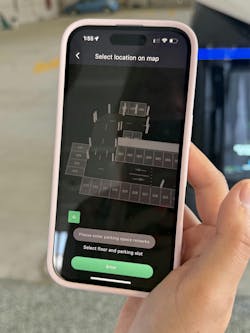Charging infrastructure obstacles? There’s a robot for that.
Key takeaways
- IonDynamics' EV charging solution, an autonomous robot battery pack, deploys quickly without site modifications, potentially saving fleets up to 90% of the costs of building on-site charging infrastructure.
- The FlashBot is capable of DC fast charging with a 104 kWh capacity and charging at 60 kW. The next generation will be more powerful.
- The FlashBot charges with an easily installed FlashBase, and the FlashHub power converter allows the FlashBot to act as a silent, zero-emission power generator for tools and equipment.
For years, fleets have cited charging infrastructure as one of the biggest hurdles to electrification. Some fleets that implemented EVs long ago still rely on temporary charging because of the time it takes to install permanent charging infrastructure. With the headaches of installing permanent charging infrastructure, it might be time to look for another solution.
IonDynamics, an energy mobility company, developed a scalable, modular, and even movable solution that decreases both lead time and overall costs of permanent charging infrastructure. While modular, scalable, and portable, this solution is anything but temporary—it's designed to easily scale with the fleet business and easily adapt as charging technology progresses.
IonDynamics developed the Flash suite of equipment to aid commercial and government fleets in their EV charging operations, Josh Bitterman, founder member of IonDynamics, told FleetOwner. The Flash suite enables fleets to more easily charge their equipment with an autonomous, robot charger that moves from vehicle to vehicle. This prevents fleets from having to plan parking around their EV charging stations, play fruit basket turnover with their EVs each time a vehicle’s charging is complete, or wasting time at public charging stations, Bitterman said.
IonDynamics’ EV charging solution essentially includes three parts: the charger, the charger’s charging hub, and a power converter.
See also: Where alt-fuel infrastructure stands today: EV charging infrastructure
IonDynamics’ three-part EV charging solution
FlashBot: the charger
FlashBot Specs
- 104 kWh battery pack (120 kWh coming in Q4 2025)
- 60 kW DC fast charging (120 kW coming Q4 2025)
- Display screen indicating the EV’s state of charge and the bot’s state of charge
- Autonomous operation from vehicle to vehicle
Easily the most interesting of the three parts, the robot EV charger, dubbed the FlashBot by IonDynamics, is essentially a remote-controlled battery pack that moves within a predetermined geofenced area, such as fleet depots, parking lots, and parking garages.
Once a driver parks their electric fleet vehicle, they can “summon” the FlashBot via a smartphone application. Drivers indicate whether the charging port is on the front, back, or either side of the vehicle to ensure the bot parks near enough for charging cables to reach without hassle.
While the bot moves quickly, depending on the size of the area, it might take one to five minutes for it to park itself. This might seem like a disadvantage, but if drivers summon the bot immediately after parking, they can use this time to finish paperwork or conduct post-trip inspections.
Once the bot is parked, drivers can grab one of the bot’s charging cables and connect it to their vehicle’s charging port.
A ribbon light surrounding the top of the FlashBot will flash blue to indicate a successful connection, and the screen on the front of the FlashBot will show the vehicle battery’s charging status, the estimated time it will take to charge, the speed of charge, and the amount of energy being used. All of this information is made available on the FlashBot’s screen without having to toggle through buttons or search within the app.
Once the vehicle is charged, it must be unplugged from the FlashBot, and then the driver can send the bot back to its base or to the next vehicle that needs a charge.
FlashBase: the FlashBot charger
While the FlashBot is more of the head turner among the three system components, the FlashBase is what makes it all happen. Because the FlashBot is essentially a robotic battery pack, it must also be charged regularly. That’s where the FlashBase comes into play.
The FlashBase is the only part of the system that draws power from the grid. To accomplish this, a 240V outlet is required. Further, it draws power slowly, meaning it won’t hike electricity bills. But while it draws power slowly, the FlashBase can fully charge two FlashBots in one hour using FlashLink connectors.
Currently, the FlashBot requires human interaction to link the bot to the charging port, but IonDynamics is working on an autonomous connection between the bot and the base. This will enable the bot to link with the base without any human intervention, meaning that the bot can keep its battery pack charged throughout the day fully on its own.
IonDynamics hopes to deliver this feature within the next 12 to 18 months, according to Bitterman.
See also: What goes into planning an electric truck charging station?
FlashHub: the power converter
The third part of the system is the FlashHub, which converts power from the FlashBot so that the bot essentially becomes a silent and zero-emission generator, able to power tools and other equipment at remote job sites.
To use this function, the FlashBot must be connected to the FlashHub, then the FlashHub converts DC power to AC power. At that point, tools and devices can be plugged directly into the FlashHub.
Further, IonDynamics “can configure whatever power output is needed for the customer,” Bitterman said, whether that’s “400V, 220V, 110V,” and more.
IonDynamics’ European customers have taken advantage of this feature the most, with Bitterman stating that the split of FlashBots used strictly as EV chargers and those strictly used as off-site generators is 50-50 across the pond. In fact, IonDynamics has a significant partnership with Netflix, using the FlashBots and FlashHub to provide power to the company’s film sets in Hungary.
An EV charging and mobile power solution
Each of the three aspects of the FlashBot charger is designed to work outside within the elements. While the bot hasn’t driven itself off-road, it can be easily directed onto a trailer and taken to remote locations.
Currently, there are roughly 40 FlashBots in service in the field: 20 in the U.S. and 20 in Hungary. Additionally, IonDynamics has had recent partnerships with auto manufacturers such as Audi and Stellantis.
Earlier this year, IonDynamics supplied power to a commercial shoot of the new electric Dodge Charger at Detroit’s Eastern Market. It also topped up the charge of multiple electric Dodge Chargers before they were sent to dealerships to sell.
The City of Detroit also charges its fleet of six Ford E-Transit passenger vans using two 60 kW FlashBots.
See also: Charging innovations of 2025
While the Flash suite consists of the FlashBot, FlashBase, and FlashHub, if EV charging is the fleet’s primary objective, a purchase or a lease of the FlashHub is not required. Further, IonDynamics can scale the equipment depending on the size of the fleet and the area of the depot.
“We customize the equipment recommendations to meet the site needs,” he said. “The equipment can be leased à la carte or packaged together. We apply volume discounts based on both term and volume of equipment being leased.”
With the IonDynamics Flash suite, there is no need for site modifications outside of the installation of a 240V outlet. This means implementing a FlashBot and FlashBase can help fleets save up to 90% of the cost of developing charging infrastructure on their site, according to IonDynamics. What’s more, Bitterman said the technology inside the FlashBot was designed with the future in mind, able to adapt to technological advances—something he said many current EV chargers lack.
The current generation of the FlashBot was developed in 2023, and testing began just over a year ago in the summer of 2024. In early Q4 of this year, IonDynamics plans to release a more powerful second-generation FlashBot that will have a 120 kWh battery pack and will be capable of charging vehicles twice as fast with 120 kW of power.
About the Author
Jade Brasher
Senior Editor Jade Brasher has covered vocational trucking and fleets since 2018. A graduate of The University of Alabama with a degree in journalism, Jade enjoys telling stories about the people behind the wheel and the intricate processes of the ever-evolving trucking industry.





